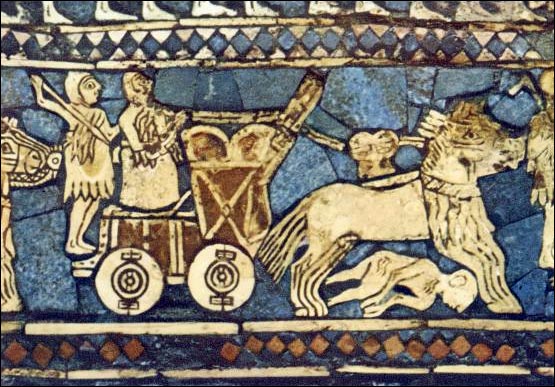 |
Date ca. 2500 B.C. Origin The Ancient World : The Middle East : Pre-Sargonid Period Description a) Scenes of triumph at war, arranged in three registers; bottom register, four war chariots, each with helmeted driver and armed warrior, drawn by four-span of onagers which gallop over fallen bodies of enemy or walk in stately progression; central register, armed warriors in battle garb driving before them naked, bound prisoners; top register, king, portrayed a head taller than his men, standing before warriors and his empty war chariot to receive naked bound captives being paraded before him; b) detail of second war chariot from left in bottom register. The so-called Standard of Ur, a hollow wooden box with four sloping sides, was found in one of the graves of the Royal Cemetery at Ur (see 2Bd.057-.058). Its mosaic scenes seem to commemorate a specific military victory, with special emphasis laid upon the captives and booty seized and the lavish banquet held afterwards in celebration (pictured on the opposite face, see 2Bd.049) War was an important aspect of life during the late Early Dynastic period in southern Mesopotamia, as city-states disputed over boundaries, vied for supremacy, and erected monuments to their victories (see also 2Bd.017-.018). Success in battle was a gift from the gods, a token of special favor to be celebrated and commemorated for all time. Frankfort notes that mock battles were one form of the various archetypal acts, conveying the message that life rises triumphantly from its bondage in the miracle of renewal, which formed part of the New Year celebration. To a people much pre-occupied with warfare, military victory was undoubtedly a symbol of supreme triumph, denoting the conquest of supernatural, as well as human, enemies. The king who had been successful in battle against his neighbors would be successful in his battle against the forces of death, and the members of his triumphal legions would continue to bask in his glory. Object Standard (inlaid; shell, lapis lazuli, red limestone; ht. 7 7/8", 1.18 1/2"). Style or School Mesopotamian. Early Dynastic III. Material or Technique Mosaic. Provenance Found at Ur; Royal Cemetery PG 779 (U.11164). Repository or Site London: Mus., British; No. 121201. Image Sources a,b) from Parrot.* [JF 1239a,b] References *Parrot, A., Sumer (1961), pp.144,146,149; pls.176,175. Frankfort, H., Kingship (1948), p.317. Woolley, C.L., Ur Excavations II (1934), pp.61-62,266-274; pl.92. Strommenger, E., Mesopotamia (n.d.), P.397; pls.72,XI. |